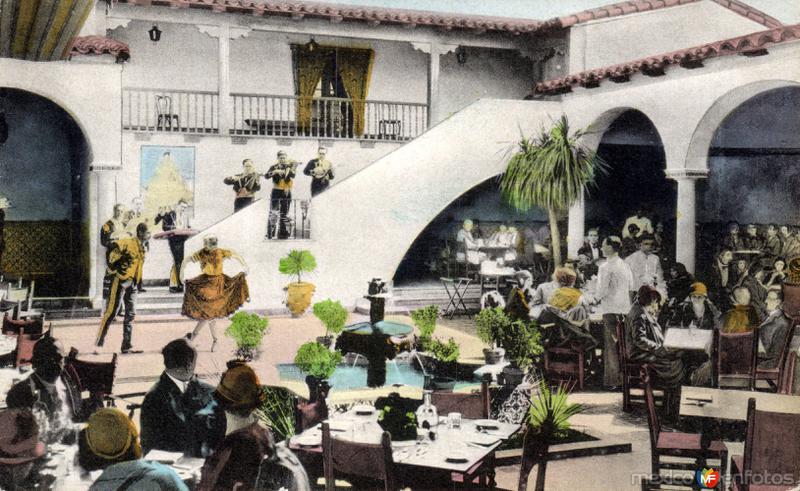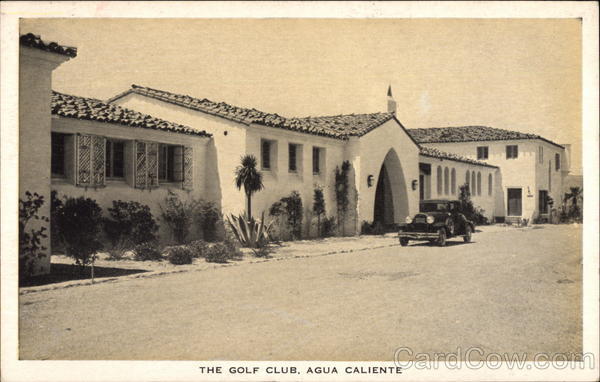Casino Tijuana Agua Caliente
The Agua Caliente Casino and Hotel opened in 22 June 1928 in the Mexican city of Tijuana, Baja California. It was a lavish resort that included a casino, spa, championship golf and tennis facilities, its own airstrip, and a lot of entertainment. Stylistically, the resort was an amalgam of Mexican colonial, California mission, and neo-Islamic designs that ranged from mosaic minarets, to cozy guest bungalows, to steaming Turkish baths. It was designed by 19-year-old architect Wayne McAllister and built by Baron H. Long, Wirt G. Bowman and James N. Crofton. Some sources note the fourth partner was Abelardo L. Rodríguez, Military Commander and Governor of Baja California, and future Mexican President. The $2.5 million Agua Caliente racetrack opened in December 1929.
A construction worker died Monday morning at the recently opened Agua Caliente Cathedral City casino. Jay Ayers, 41, of Temecula, was fatally injured at 5:20 a.m. Palm Canyon Drive. Casino caliente is more than one! Just to make sure that everyone knows casino caliente has more than one location and the safest is the one by the Greyhound track,some of the others are full of suspicious people specially the one on Ave revolution and the carrusel location.

Drinking, gambling, and horse racing were illegal in neighboring California, so many wealthy Americans and Hollywood celebrities flocked to Agua Caliente. Rita Hayworth was discovered there while performing in a show. The films In Caliente and The Champ were filmed on location there. The highlight of the opulent casino was the Gold Room, where patrons could only bet using gold chips, with a rumored $500 minimum wager. Bugsy Siegel cited Agua Caliente as his inspiration for building the resort on what became the Las Vegas Strip.
Mexican PresidentLázaro Cárdenas outlawed gambling in 1935 and closed the resort. It became a state-run school, Escuela Preparatoria Federal Lázaro Cárdenas and eventually fell into disrepair. Remnants of the original buildings remain next to the Plaza Minarete strip center at the end of Avenida Sanchez Taboada. Although the casino and hotel were closed, the racetrack continued to operate for many years. The original grandstand structure was destroyed by fire in 1971, but was rebuilt and continues to operate today as the Agua Caliente Racetrack and casino, a branch of the Casino Caliente chain.
See also[edit]
References[edit]
The Agua Caliente Story: Remembering Mexico's Legendary Racetrack, David Jimenez Beltran (Blood-Horse Publications: Lexington, Kentucky) 2004
The Leisure Architecture of Wayne McAllister, Chris Nichols (Gibbs Smith, Publisher: Layton, Utah) 2007 [1]

External links[edit]

The Agua Caliente Racetrack (current name “Caliente Hipódromo“) is a greyhound racing and former horse racing track in Tijuana, Baja California, Mexico. It opened in December 1929 at a cost of $2.5 million.[1]
One year before, the Agua Caliente Casino and Hotel opened in June 1928.
Now the largest branch of the Caliente casino chain, the renovated building houses a casino with race betting, hundreds of slot machines, a restaurant and a Starbucks café. The complex includes the Estadio Caliente sports and concert stadium.
Like the resort, the racetrack was designed by Wayne McAllister and built by wealthy Americans Baron Long, a Los Angeles nightclub owner, Wirt Bowman, owner of the Tijuana gambling establishment, The Foreign Club, and James Croffroth, a member of the local Tijuana horseracing establishment. Some sources note the fourth partner was Abelardo L. Rodríguez, Military Commander and Governor of Baja California, and future President of Mexico.[2] The lavish resort and racetrack on the Mexican border was popular among Americans, particularly Hollywood celebrities, because drinking, gambling and horse racing were still illegal in most of the neighboring U.S. states. The first manager of the track was Tommy Gorman, who had previously been involved in ice hockey.[3]
Although PresidentLázaro Cárdenas outlawed gambling in 1935 and closed the resort and casino, the Agua Caliente Racetrack continued to operate for many years. It was the site of several industry firsts, including starting gates, safety helmets, and “pick six” wagering. Both Phar Lap and Seabiscuit ran and won the Agua Caliente Handicap, which for a time was the richest in North America.[4]
In 1939 Anna Lee Aldred received her professional license from the Agua Caliente Racetrack, becoming the first U.S. woman to receive a jockey's license.[5][6][7]
Such riders as Aureliano Noguez, Humberto Enriquez, Francisco Mena, Antonio Castanon and David Flores graced the jockeys' quarters throughout the days of horse racing.
The race track is the originator of the Pick 6 (on the North American continent). Then known as the 5-10 and later on the 4-9'er. Some racetrackers called it the Big Six.
The original grandstand structure was destroyed by fire in 1971, but was rebuilt and continues to operate today, though just a shadow of its opulent beginnings.[8] It is currently owned by millionaire politician Jorge Hank who renamed it 'Hipódromo de Agua Caliente'. It has not hosted horse racing since 1992, but presents greyhound races. The building was renovated in the 2010s and the Estadio Caliente stadium was built in the grounds.
References[edit]
- ^Wesch, Hank. 'Agua Caliente celebrates 75 years with little fanfare The San Diego Union-Tribune'. Signonsandiego.com. Archived from the original on 2012-03-24. Retrieved 2016-09-09.
- ^'Archived copy'. Archived from the original on 2006-09-01. Retrieved 2006-10-26.CS1 maint: archived copy as title (link)
- ^The Gazette 1929, p. 13.
- ^'Archived copy'. Archived from the original on 2008-06-27. Retrieved 2008-06-20.CS1 maint: archived copy as title (link)
- ^Post, Claire Martin The Denver. 'ANNA LEE ALDRED, 85, JOCKEY PIONEER'. Sun-Sentinel.com.
- ^Press, The Associated (July 5, 2006). 'Anna Lee Aldred, 85, Hall of Fame Cowgirl, Dies (Published 2006)' – via NYTimes.com.
- ^Simon, Mark (2007). The Original Thoroughbred Times Racing Almanac. pg. 37. i-5 Publishing. ISBN978-1-933958-38-5.
- ^Pierson, Cindy. 'Top Horse Racing Books for Beginners'. Horseracing.about.com. Retrieved 2016-09-09.
Bibliography[edit]
- Vanderwood, Paul J. Satan's Playground: Mobsters and Movie Stars at America’s Greatest Gaming Resort (Duke University Press, 2010)
- Beltran, David Jimenez. The Agua Caliente Story: Remembering Mexico's Legendary Racetrack (2004) Eclipse PressISBN1-58150-115-3
- Chris Nichols. The Leisure Architecture of Wayne McAlli [1] (Layton, Utah: Gibbs Smith) 2007
- The Gazette (July 9, 1929), 'Eddie Gerard has Resigned Post of Maroon Manager', The Gazette, Montreal
External links[edit]
- Location on the map of Tijuana
Casino Tijuana Agua Caliente Leche
Coordinates: 32°30′24.25″N116°59′43.77″W / 32.5067361°N 116.9954917°W